#baekja
Explore tagged Tumblr posts
Text

Moon Jar
Unknown Artist
baekja (white porcelain), 18th Century
66 notes
·
View notes
Text
i keep seeing people getting a little confused about the titles and terms used in rotbb so i thought id make a quick little guide on the more common titles and pre/suffixes used in the novel/manhwa
for minor context, members of a sect may take on the names that denote which generation they come from within the sect (current mount hua consists of, in order from eldest to youngest, the hyun line, the un line, the baek line, and the chung line, though the true generational naming convention would have typically been chung > myung > hyun > un > baek, which would then repeat in a cycle) however taking on a generational name isnt necessarily required/enforced (ex. yu iseol, yoon jong, jo gul, etc do not take on generational names)
in his previous life, because chung myung was raised in the sect since infancy, he took on the chung generational name as his ‘birth’ name, as the chung line was the generation he was raised in. when he reenters mount hua post resurrection, he becomes a third class disciple, aka the current era chung disciples
TITLES
jangmun: sect leader, jangmun'in is used when speaking directly to the sect leader (ex. hyun jong, chung mun)
sasuk: senior martial brother, used by disciples of a different rank to senior disciples of higher ranking (ex. the chung disciples referring to the baek disciples, the baek/chung disciples referring to the un disciples)
sajil: junior martial brother, used by disciples of a different rank to junior disciples of a lower ranking (ex. the un disciples referring to the baek/chung disciples, the baek disciples referring to the chung disciples)
sasukjo: great martial uncle, used by disciples referring to the line above sasuk
sajo: martial grandparent/ancestor
sason: martial grandchild/descendant
sahyung: senior martial brother, used by disciples within the same rank to disciples who entered the sect earlier than them (aka chung myung referring to the elder chung disciples, chung disciples referring to yoon jong)
sajae: junior martial brother, used by disciples within the same rank to disciples who entered the sect after them (ex. the chung disciples referring to the chung disciples)
sajeo: senior martial sister, same as sahyung but used for women
sago: senior martial sister, same as sasuk but used for women (ex. tang soso referring to yu iseol)
samae: junior martial sister, same as sajae but used for women (ex. baek cheon referring to yu iseol)
dojang: disciple (ex. older characters use this to refer to chung myung/disciples of a sect)
hyung: meaning older brother, used by males when referring to their older brother or to an older male colleague one is friendly with
hyeonja-bae: referring to the hyun generation
unja-bae: referring to the un generation
baekja-bae: referring to the baek generation
cheongja-bae: referring to the chung generation
maehwa geomjon: plum blossom sword saint
hwasan shinryong: mount huas divine dragon
amjon/amzone: dark saint
maknae: used to refer to the youngest person in a group of people
PRE/SUFFIXES
-ah: a suffix that denotes casual familiarity typically used for those who are younger than the speaker or are of the same social standing, used at the end of a name if the name ends in a consonant (ex. hyun jong calls chung myung ‘chung myung'ah’)
-ya: a suffix that denotes casual familiarity typically used for those who are younger than the speaker or are of the same social standing, used at the end of a name if the name ends in a vowel (ex. chung myung calls tang bo ‘tang bo'ya’)
-nim: a respectful suffix that essentially means mr/mrs/miss
dosa: meaning taoist (ex. tang bo typically refers to chung myung as hyung nim/dosa hyung/dosa hyung nim)
-jon: a title given to martial artists who have mastered their respective martial arts perfectly, the most honourable title a warrior could get, translated to as ‘saint’ in the novel or 'supreme' in the manhwa (ex. plum blossom sword saint, dark saint)
please keep in mind however im not fluent in korean nor am i fully familiar w these terms of address and am using my knowledge of chinese honorifics and titles as they follow a similar formula.. if ive mislabeled something or used an unfaithful/misleading description, or if you just have more to add that i havent listed, please lmk!
#return of the blossoming blade#return of the mount hua sect#rotmhs#rotbb#화산귀환#made this specifically so i can stop seeing manhwa only readers referring to chung mun aka chung myungs brother/father figure as jangmun..#HIS NAME IS CHUNG MUN...!!!!!! JANGMUN JUST MEANS SECT LEADER...!!!!!!!!!!!!#will never understand why the eng manhwa translated sahyung to brother but didnt even bother translating jangmun...?#so now we've got people out here STILL thinking his name is jangmun when chung myung was actually referring to him as jangmun sahyung#aka elder martial brother sect leader (literally).. or just brother sect leader#spent like an hour writing all this down..yalld better appreciate this
306 notes
·
View notes
Text
Idk if this is a controversial opinion...
I enjoyed Hwarang but the whole Ah-ro crying almost every episode felt like a turn off... Like, I get the first few times because she genuinely had a reason. Her brother comes back and they're reunited as a family then *gasp* he's not actually his brother??? But it gets repetitive and she ends up crying a lot.
Not really into the whole siblings end up dating each other trope even if they're supposed to be fake siblings. Idk, maybe I'm just sensitive? I feel like if Sunwoo just acted like a brother to Ah-ro it would've been fine. The whole love triangle thing between her, her fake brother, and the king in hiding was... meh (?)
I'd rather ship Banryu and Sooyeon, heck, even Yeowool and Hansung TT
But I know Hwarang is heavily based on the actual Hwarangs of Silla back then. But as a kdrama? I feel like I would've enjoyed it better as an action or slice of life kind of kdrama. The ending also felt kind of rushed, I don't know if it's just me, but it felt incomplete.
The first few eps were more like "ok here's the new task, you have to pass this assignment or else you'll be kicked out of the Hwarang house." Then it got political (which I understand), but then the fake siblings duo has a conflict. Their conflict being "uh oh, i love this guy but he's supposed to be my brother! But it should be fine, rigjt..? Because he's not my actual brother." Enter Princess Sookmyung having the hots for Sunwoo as a side plot. Meh idk man, maybe it would've been better if it was like Jinheung x Ahro and Sookmyung x Sunwoo? Then the whole Baekjae arc happens. Imo there should've been more episodes ;_;
Other than that, I enjoyed it. The characters were pretty fun and I liked watching them bond.
2 notes
·
View notes
Note
Hey! One of the anons said that their high school entrance exams will take place in November or December? So i googled a bit and found that south korea's College entrance exam take place in that time. And their final year has started on March. So isn’t the year gonna end in next year February? I am also telling this cuz Jisu has transferred in baekjae in 1998 april and their third year started 1999 march. So it’s a one year period. Jisu has transferred when their second year firsr semester started and Cheol has transferred in 1998 October. They said earlier that cheol has transferred in the middle of second semester. So even if the story finishes with their middle school graduation isn’t it like in February 2000?
Thank you for reminding me about graduation because it's hard keeping in mind the differences in other countries! You're right, middle school graduation is in February, I forgot about that. So it would be more precise to say that I think the main story will end with their last day of school in December 1999. In that case, the graduation could be an epilogue or flashforward! Winter break actually starts in December around Christmas and depending on the school, it can last until late January/early February.
So in September the new school period starts,
in October they will have mid-terms,
and in December they will probably have the final exams. I guess the entrance exam should be around this time as well.
Right now it's late July, the beginning of summer break so I wonder if the story will cover all the months until December or something unexpected happens.
3 notes
·
View notes
Text
Ini 14 Tempat Menarik di Gyeonggi-Do Korea
INI 14 tempat menarik di Gyeonggi-do Korea, sebuah provinsi yang dianggap sebagai titik awal dari perjalanan di Negeri Ginseng itu. Ada berbagai situs yang berlokasi di sana. Situs-situs itu mulai dari masa prasejarah sampai era Baekjae, Goryeo, dan bahkan Dinasti Joseon. Lokasinya yang mengelilingi Seoul, membuat Gyeonggi-do, mudah diakses. Ini 14 Tempat Menarik di Gyeonggi-Do Korea: Anseong,…
#anseong#anyang#carribean bay#everland#farmland#gwangmyeong cave#heyri art valley#hwadam forest#imjingak pyeonghwa-nuri park#jebudo island#korean folk village#petite france#pocheon art valley#pocheon herbs island#suwon hwaseong fortress#tempat menarik di gyeonggi do korea
0 notes
Text
The Moon Jar: A Global Icon of Korean Art
Korean art has a diverse and rich tradition that spans centuries, and within its context of art, the Moon Jar stands out as an iconic work of art that transcends both time and. The Moon Jar, with its simple, elegant form and striking white glaze, has become a symbol for Korean art and is a revered artifact that is adored across the globe. In the article below, we'll look at the significance, story, and enduring attraction of the Moon Jar as a symbol of global Korean art.

The Artistic and Cultural Significance of the Moon Jar
Moon Jar Moon Jar is a type of traditional Korean porcelain vessel that is referred to by the name of "Baekja," which translates to "white ware." Its basic and elegant form is distinguished by its round, full moon-shaped shape and a white, milky glaze. This iconic design represents the essence of simplicity and purity, reflecting its influence from Confucianism and Taoism as two significant cultural and philosophical elements of Korea's past. Moon Jar Moon Jar is commonly regarded as a symbol of balance, harmony, and the search for a flawless minimalist aesthetic.
The Moon Jar's significance in the world of culture isn't just about its aesthetics. It's a perfect mixture of spirituality, art, and nature, emulating nature's Confucian and Taoist values of living in harmony with nature. The unadorned, simple vessel conveys a powerful message about the importance of simplicity and pureness amid a complicated world.
Historical Origins of the Moon Jar
The story of the Moon Jar can be traced through the late 17th century in the Joseon Dynasty, commonly called the golden age of Korean ceramics and pottery. Moon Jars were initially made to serve the royal court and noble families, expressing their admiration of art and culture.
There is a belief that the Moon Jar was named for its shape, resembling the moon at full. These jars were mostly used to store fermented food items and other necessities of daily life. They were, however, more than just functional. They were also appreciated as art pieces and were a fixture in the houses of Korean elites.
The process of creating Moon Jars is labor-intensive and requires the skill of skilled artisans. Each jar is constructed by hand with clay coils, which makes the distinctive, rounded form. Following firing, each jar gets coated with a white glaze. This can result in small variations in texture and color that add to the uniqueness of each.
The Global Recognition of the Moon Jar
Through the years, the reputation of the Moon Jar has transcended borders and has earned it worldwide recognition as an icon in Korean arts and culture. Its timeless, minimalist style appeals to art lovers, collectors, scholars, and other art lovers across the globe. Moon Jars are displayed in galleries, museums, and private collections worldwide and remain a source of inspiration for artists and creatives.
The worldwide fascination for this particular Moon Jar was further reinforced in 2013 when The British Museum in London acquired an important Moon Jar, emphasizing its importance to the global culture. This acquisition put this Moon Jar at the forefront of discussions around culture, art, and appreciation of cross-cultural exchange.
The Beauty of Imperfection
One of the most fascinating features is its willingness to accept imperfections. The art of hand-crafting these jars usually results in variations in the design and glaze, which makes each one distinctive. In a society that increasingly is a fan of uniformity and precision, Moon Jar's imperfections are an important symbol of the uniqueness in diversity and individuality.
The Moon Jar's transformation from a prized cultural treasure in Korea to an international art symbol proves its timeless appeal and beauty. The simple, elegant form has significant philosophical and cultural value, reflecting Korea's rich heritage and art tradition.
In honor of the worldwide recognition of the Moon Jar and its potential to bring inspiration across boundaries, it connects people worldwide in awe of its simple, beautiful form. This Moon Jar is much more than an art piece. The auction calendar on Auction Daily keeps you up-to-date on all the major events in the auction industry. It's your go-to resource for planning your bidding strategy and ensuring you never miss an opportunity to acquire that perfect piece.
0 notes
Text
Korean Art and Craft: A Fusion of Timeless Traditions
Korean art and craft are a mesmerizing fusion of several traditions from this culturally rich country. Rooted in ancient customs, these art forms have evolved over the centuries, encompassing calligraphy, pottery, painting, and handicrafts. Utilizing a diverse array of mediums, colors, textures, and materials, these artistic skills have been passed down through generations by master craftsmen. Let's delve into the unique and captivating world of traditional Korean art and craft.
Calligraphy - An Art of Elegance:
Among the most cherished Korean art forms is calligraphy, the art of handwriting. Its origins lie in China but were embraced and refined by Korean artists over the centuries. The beauty of calligraphy lies in the character lines, brushstroke intensity, and nuanced tones of ink. Calligraphers often use the "Four Treasures of the Study" - paper, brush, ink stick, and inkstone - to create their masterpieces. This art form shares a connection with ink and wash painting, as both utilize similar tools.
In Korean calligraphy, the "Four Friends" are paper, a brush, an ink stick, and an ink stone, collectively known as Munbangsawoo. Traditional hanji, made from Korean mulberry, is a preferred paper for calligraphy, offering excellent absorbency and reflection of ink. Calligraphy in Korean art encompasses various styles, including script calligraphy, cursive or grass script, block script, and official script.
Korean Pottery - A Tale of Timeless Beauty:
Korean pottery is another exquisite art form deeply ingrained in the country's history. Three main types of Korean pottery are commonly distinguished - Cheongja (blue-green celadon), Buncheong (slip-coated stoneware), and Baekja (white porcelain). Each type holds its own unique allure, but the white porcelain, in particular, has garnered praise from collectors worldwide.
Goryeo Celadon, crafted between 700 and 1,000 years ago, is renowned for its jade blue color and intricate inlay decoration. White porcelain, the primary ceramic art between 100 and 600 years ago, features motifs painted with oxidized iron, copper, or cobalt blue pigments imported from Persia via China. On the other hand, Buncheong porcelain, developed by Goryeo potters, gained popularity under the Joseon dynasty, presenting a realistic and unpretentious style.
Handcrafts - A Reflection of Artistry:
Korean artisans once created an array of handcrafted goods for their homes, showcasing their skill and creativity. They wove beautiful baskets, boxes, and mats using bamboo, adorned with natural black and red lacquer for durability and beauty. Masks, dolls, and ceremonial ornaments made from Korean mulberry paper demonstrated their artistry.
Embroidery, decorative knot-making (made up), and natural dyes also played a significant role in traditional Korean arts and crafts. The art of hand embroidery, the most time-consuming and skill-intensive of all, captivates with its intricate designs of silk flowers and animals. Additionally, jogakbo, made by stitching small pieces of fabric together, serves as both wrapping cloth and an artistic marvel.
Paintings - Portraits of Korean History:
Painting has long been the cornerstone of Korean art, providing glimpses into the country's beliefs, artistic sensibilities, and techniques. Goguryeo tomb paintings, dating back centuries, offer valuable insights into early Korean artistry and beliefs. Goryeo artists excelled in capturing Buddhist icons, while Joseon's literary elite were drawn to idealized landscapes and plant and animal symbolism.
Types of Korean paintings include Daoist paintings, Buddhist paintings found in abundance at temples, Confucian paintings with themes of fidelity and filial piety, and decorative paintings used for ornamental purposes. The works of artists like Kim Hong-do and Sin Yun-bok added diversity and realism to Korean art, depicting scenes of everyday life and even moments of intimacy.
Korean art and craft, a treasure trove of diverse traditions, continue to inspire awe and admiration. These art forms, from calligraphy's graceful strokes to pottery's timeless beauty, reflect the nation's rich cultural heritage. The preservation efforts by organizations like the National Intangible Heritage Centre and the Korea Cultural Heritage Foundation have ensured that these masterpieces remain alive and cherished. Today, galleries and exhibits proudly showcase these crafts, offering an invaluable glimpse into Korea's illustrious history and artistic legacy.
#korean#art and design#KoreanArt#KoreanCraft#TraditionalKoreanArt#KoreanCalligraphy#KoreanPottery#KoreanPainting#HandicraftsKorea#KoreanHandEmbroidery#KoreanCulturalHeritage#ArtisticKorea#KoreanArtists#KoreanArtGallery#KoreanArtisans#KoreanCeramics#KoreanFolkArt#KoreanCulturalArt#KoreanArtisticTraditions#KoreanArtLovers#KoreanArtAppreciation#KoreanArtandCrafts
0 notes
Photo








“She moves in tides and I orbit around, I pull and I pull but I never get quite close enough to reach her surface with the tip of my toe.” — effyeffa (or, a look at the evolution of the space between Song Jain and Baek Yikang: part three)
#the nokdu flower#song jain#baek yikang#han yeri#jo jung suk#baekja#i .....somehow forget about their kiss all the time#and then when they kiss i'm like.........thanks i'm dying#mine
44 notes
·
View notes
Photo









My bobohu is so cute 💘🦁
2 notes
·
View notes
Text




Moodboard for Nokdu flowers current episode
#so much pain#and tragedy#somebody better find my girl song ja in#baekja needs to be reunited bext episode#spoilers#nokdu flower#mung bean flower#baek yi kang#song ja in#baek yi hyun is becoming more dark#as always their father and his family in general are trash#we only stan ye wol in this house#hope everyone survives the war
2 notes
·
View notes
Text




Baekja Dragon Couple Hanbok
2 identical clothigs, including 11 swatches each.
Public Access available on 08/24/2022.
DL
P.S. The EA official announcement was updated, so from BFF tier, you can download my items 3 weeks in advance. Thank you!
#sims4#the sims 4#sims 4 download#sims 4 korean cc#sims 4 korean cc creator#sims 4 cc#sims 4 hanbok#sims 4 korean#sims 4 korean traditional#sims 4 custom content#sims 4 historical
25 notes
·
View notes
Text
Cafe Edition: Seoulism
🇰🇷 서울리즘
📍435 Yes Building 1, Floor 6, Baekjae Goboon-ro, Songpa-gu, Seoul
📆 Year-round
Looping on from my last post, one of the best ways to get stellar views of the Lotte World Tower is to take a trip to Seoulism Cafe.
According to Travel-Stained, in 2021 the famous SEOUL sign with the backdrop of the Lotte World Tower has been tagged on Instagram over 10,000 times (and this was a year ago, so by today it’s probably another 10,000 more!)

(source)

(source)
Everything that I’ve read so far about Seoulism emphasises three things - the incredible views, the fact that it is unassuming from the outside, and the fact that you need to purchase at least one drink to stay in the cafe (I guess because of the influx of people wanting to take in the views for the ‘Gram).
Also, the drinks are expensive, even by Seoul standards.
So let’s go one by one through these three things.
Apparently, Seoulism is on the sixth floor of an unassuming building in the middle of a not-as-touristy area of Songpa. It’s not until you are actually inside the elevator of the building that you can see you’re in the right place.
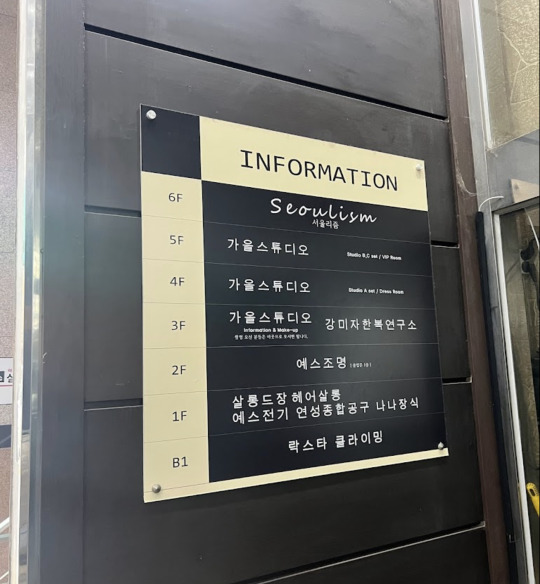
(source)
Inside though it’s another story. Spacious with a heady mix of modern and vintage and with amazing views of the city, Seoulism looks like some sort of hidden treasure. There is a roomy interior, as well as a covered patio/deck.
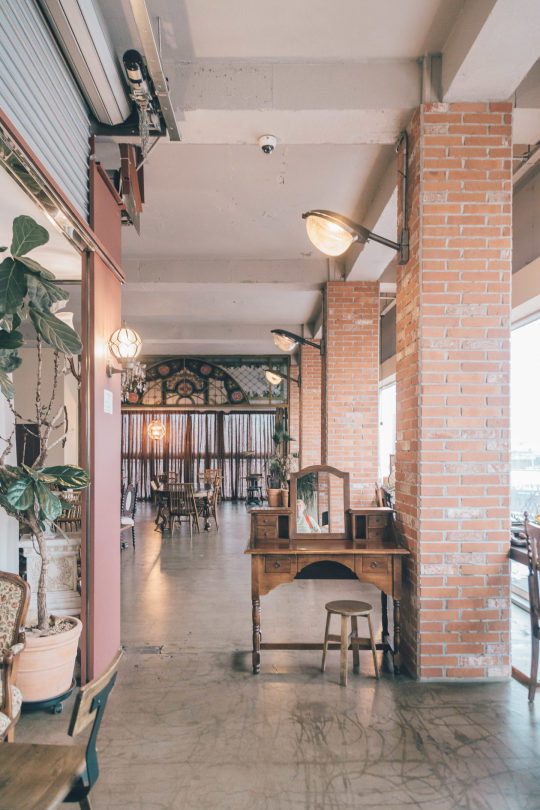
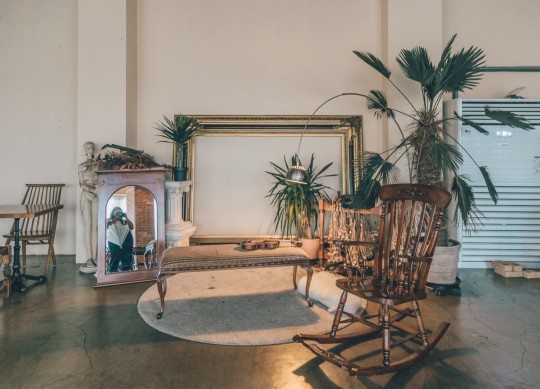
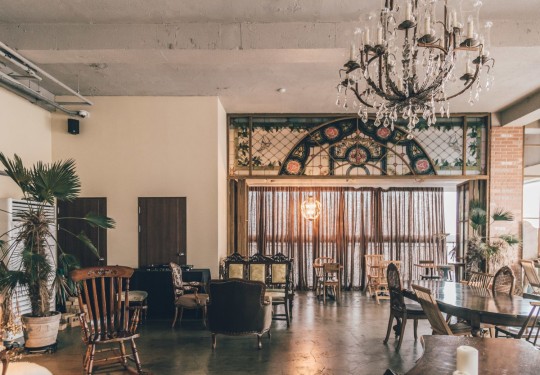
The interior is spacious, with eclectic vintage Victorian furnishings set against the sleek modern ceiling to floor windows showing the Seoul skyline. (source)
The deck/patio is covered, and fully accessible despite the weather.

(source)
If you visit Seoulism’s official Instagram right now, you can see images of how beautifully decorated the cafe is for Christmas.


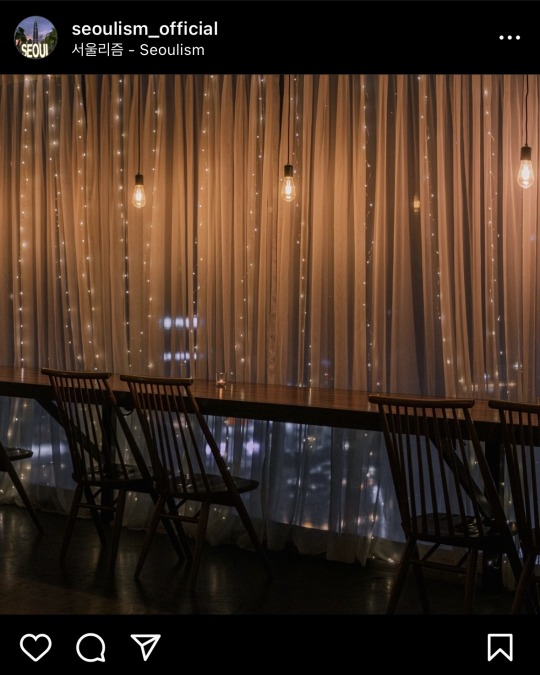
(source)
Everything is designed to be picturesque and invites photography, and it became so popular for that reason they had to institute a rule that in order to spend time at the cafe, you have to buy a drink for each person wanting to take a seat inside.
Menu
Because of the premium views, Seoulism is more expensive than other cafes in Seoul. But one of the first photos I ever saw that lead me to Seoulism was their Cherry Blossom Latte, and I would pay a pretty penny just to try one of those, even without Seoulism’s Instagrammable atmosphere.
But the “exorbitant” menu item prices are one of the comments I consistently saw when looking at people’s reviews of the cafe.

(source)
Some menu items include:
Signature Salted Caramel Cream Latte: 8,500 KRW
Signature Coconut Frozen Latte: 11,000 KRW
Espresso: 7,000 KRW
Cold Brew Coffee: 11,000 KRW
Cold Brew Latte: 11,000 KRW
Apple Mint Milk Tea: 11,000 KRW
Berry Aide: 8,000 KRW
I wouldn’t even hazard to convert those prices to US dollars or Australian dollars now, with the way the economy keeps sliding all over the place. But compared to other cafes in Seoul, it’s quite a marked difference.
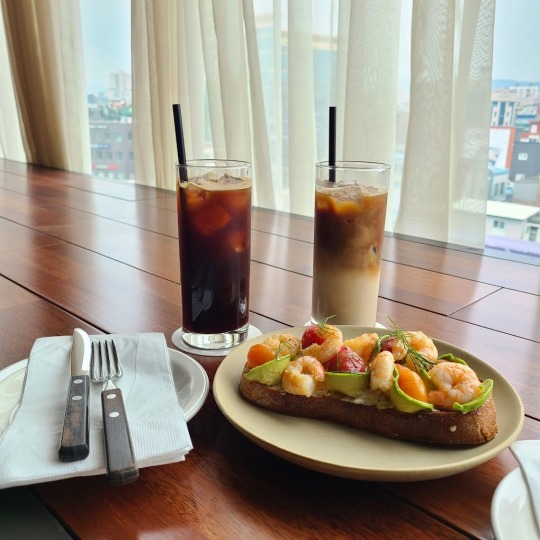
(source)
There’s also pastries and desserts ranging from 7,000 to 15,000 KRW.
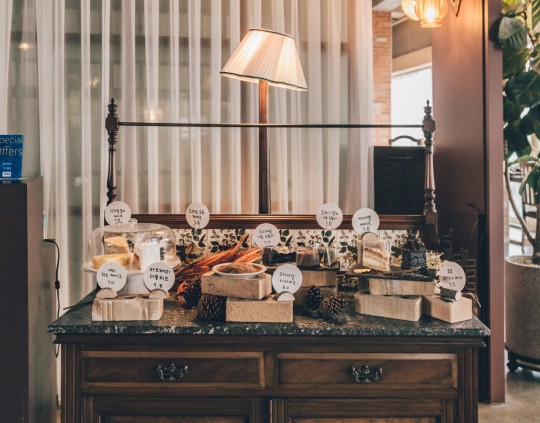
(source)
At night, Seoulism turns into a cocktail bar with a range of alcoholic drinks. These are also, as you can imagine, very expensive.
But I feel as though it would be worth it purely for the experience and to take views. Imagine going during the cherry blossom season??
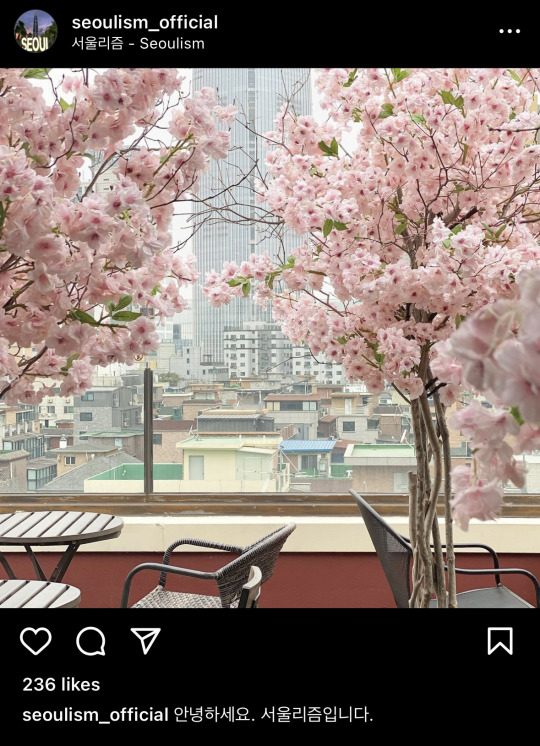
(source)

Further Information and Sources:
Google Reviews
Seoulism Official Instagram
There She Goes Again
Travel-Stained
Wander With Jin
OhFISHiee
In this blog I leaned very heavily on There She Goes Again and their gorgeous photos of Seoulism. I could only dream of taking photos as amazing as that.
5 notes
·
View notes
Photo









180415 EXO-CBX Vlive // Meet Baekja, Daeja & Seokja
#exo#exosnet#baekhyun#chen#xiumin#cbx#gif#all#this was the best broadcast#what happen when u leave makeup to th boys#gif:vlive
959 notes
·
View notes
Text
Gyeongju
Day 1 part 2.
We then went to the museum, at this point the novelty and fun of the scooter had run out and i looked like a cold ninja turtle.

I wasnt driving btw, i dont know how to drive. I am too scared to learn i can barelu drive a bike..anyway.



So the bell it says that it is the oldest bell of its type in Korea at least in records and according to T legend has it, it's ring sounds like a babies cry, it says so in the Korean inscription but not the english one. I kinda learned a bit more of Koreas History and how its divided, and i understand that but when i try to add it to the historical timeline i have in my head i somehow canr because colombian records of a time before Columbus are very little and so its divedes kinda like "pre civilization-civilation" although i know thats wrong, and i cant remember what europe was doing at that tome but yeh after the whole cavemen yada yada stuff Korea was divided in three kingdoms Silla (now Gyeongju) Baekjae (now Seoul and surrounding areas) and Goryeo (south western side)then Silla took over the other two and then cant remember but this is around the bronze age i think.






Then we went to ...i forgot the name but it used to be a whole ass palace but now only three Kiosks have been rebuilt and i am absolutly in love with that place..i like it more than Gyeongbokgung to be honest. It's so beautiful and the reflexions were so perfect i was blown away.Korea is fucking beautiful yo.
#living in korea#living in seoul#seoul#korea#south korea#living abroad#life in korea#life in seoul#seul#travel#corea#come to korea
2 notes
·
View notes
Text
SEPTEMBER 2018 GOLD STAR MEDIA SCHEDULES & REVIEW
Note: As always, individual schedules are up to roleplayers within reason. Any major individual schedules, especially those related to points claims, should be cleared with the main first. These schedules may be updated throughout the month if new information needs to be added.
Please like this to let me know you’ve seen your muse’s schedule.
Overall company
Gold Star’s financial prospering has led to growth for the company and happy, but ever-greedy executives and investors.
September Company Schedules:
September 23-25: Chuseok (Idols will have time off from all schedules to spend with family or friends to celebrate the holiday).
Silhouette
A successful Japanese debut means a further solidified position within the company despite reaching further and further past the point where girl groups usually see their downfall. Lately, the group’s fanbase has been very active and pleased with the company for continuing to support Silhouette’s activities where Gold Star’s competition has failed to promote their older groups. Gold Star plans to ride this positive feedback to another group comeback before the end of the year.
September Schedules.
Early preparations for Korean comeback throughout month.
September 1: Silhouette 1st Japan Live Tour concert at Zepp Osaka Bayside in Osaka, Japan.
September 2: Silhouette 1st Japan Live Tour concert at Zepp Osaka Bayside in Osaka, Japan.
September 8: Performance at HallyuPopFest at Singapore Indoor Stadium in Singapore, Singapore.
September 12: Performance at Cheonan World Dance Festival Opening Ceremony.
September 14: Performance at Busan Catholic University Festival.
September 15: Performance at Gongju Baekjae Culture Festival.
September 20: Performance at Busan Dongah University Festival.
(October 5: Member Nami releases non-promoted Gold Star Portal single “Blurred Lines” with Origin’s Seyeon.)
(October 14: Performance at SBS Super Concert in Suwon.)
Aria
Besides some public performances, the group will have early concepts meetings and recordings for their next album, with a hopeful release at the very end of this year or the very beginning of next year. The title track for this album will be a more mature, girl crush concept than most of Aria’s music.
September Group Schedules:
Early preparations for Korean comeback.
September 7: Performance at HallyuPopFest at Singapore Indoor Stadium in Singapore, Singapore.
September 8: Performance at DMC Festival Concert.
September 9: Aria Asia Tour in Kuala Lumpur, Malaysia.
September 13: Member Jynx ends music show promotions.
September 14: Performance at Fever Festival 2018.
Origin
As their tour begins, they’ll be spending a lot of time overseas. During their tour, they’ll be working on songs for their next album, doing what they can on the road, and doing some recording sessions during brief trips back to Korea. Gold Star has declined most interviews and appearances while the group is on tour, except for a few major publicity events, giving the company’s cash cow at least some time off while they’re traveling. Their managers have been told to encourage the members to keep in touch with fans back home through social media and live streams after some criticism for their short promotion period in Korea. They’ll be back in Seoul and get a break from late September 22 to September 26 in order to celebrate Chuseok at home.
September Group Schedules:
September 1: Love Yourself tour concert at Olympic Stadium in Seoul, South Korea.
September 2: Love Yourself tour concert at Olympic Stadium in Seoul, South Korea.
September 10: Love Yourself tour concert at Staples Center in Los Angeles, CA, USA.
September 11: Love Yourself tour concert at Staples Center in Los Angeles, CA, USA.
September 12: Love Yourself tour concert at Staples Center in Los Angeles, CA, USA., Pre-recorded performance on America’s Got Talent airs.
September 13: Love Yourself tour concert at Staples Center in Los Angeles, CA, USA.
September 14: “A Conversation with Origin” Grammy Museum event at Clive Davis Theater in Los Angeles, CA, USA.
September 15: Love Yourself tour concert at Fort Worth Convention Center in Fort Worth, TX, USA.
September 16: Love Yourself tour concert at Fort Worth Convention Center in Fort Worth, TX, USA.
September 19: Love Yourself tour concert at First Ontario Center in Hamilton, Canada.
September 20: Love Yourself tour concert at First Ontario Center in Hamilton, Canada.
September 21: Love Yourself tour concert at First Ontario Center in Hamilton, Canada.
September 27: Attendance at United Nations General Assembly meeting to announce UNICEF's new youth agenda "Generation Unlimited" at United Nations Headquarters in New York, NY, USA.
September 28: Love Yourself tour concert at Prudential Center in Newark, NJ, USA.
September 29: Love Yourself tour concert at Prudential Center in Newark, NJ, USA.
September 30: Official end of limited album promotions.
(October 2: Love Yourself tour concert at United Center in Chicago, IL, USA, airing of pre-recorded Tonight Show starring Jimmy Fallon appearance. )
(October 3: Love Yourself tour concert at United Center in Chicago, IL, USA.)
(October 5: Live performance on Good Morning America.)
(October 5: Member Seyeon releases non-promoted Gold Star Portal single “Blurred Lines” with Silhouette’s Nami.)
(October 6: Love Yourself tour concert at Citi Field in New York, NY, USA.)
(October 9: Love Yourself tour concert at The O2 Arena in London, England.)
(October 10: Love Yourself tour concert at The O2 Arena in London, England.)
(October 12: Appearance on The Graham Norton Show airs.)
(October 13: Love Yourself tour concert at Ziggo Dome in Amsterdam, Netherlands.)
(October 14: Performance at Korea-France Friendship Concert in Paris, France.)
Impulse
The primary focus for Impulse this month is preparing for their upcoming comeback at the end of next month. The album features a lot of group member creative involvement and solo songs for each member and is a final grab at awards as awards season approaches. They’ll be filming a short reality web series in September and October following their preparations (particularly the development of their solo songs) leading up to the comeback that will be released online during comeback promotions.
September Group Schedules:
Preparations for album throughout month.
September 30: Performance at KCON Thailand in Bangkok, Thailand.
DIARY
After a more relaxed August schedule, September brings a lot of traveling, with their concert to promote the first half of their seasons series of album at the beginning of the month, and fanmeetings in the middle. Once they’ve returned to Seoul fully, they’ll be busy with last minute preparations for their Japanese release and mini-tour next month.
September Group Schedules:
Preparations for next comeback throughout month.
September 1: 4 Season s/s concert at SK Olympic Handball Gym in Seoul, South Korea.
September 2: 4 Season s/s concert at SK Olympic Handball Gym in Seoul, South Korea.
September 8: 4 Season s/s concert at Hsinchuang Gym in New Taipei City, Taiwan.
September 9: 4 Season s/s concert at Asia World Expo Arena in Hong Kong.
September 14: Fanmeeting at Mall Riomar Kennedy in Fortaleza, Brazil.
September 16: Fanmeeting at Tropical Butantã in São Paulo, Brazil.
September 22: Group radio show co-hosting.
(October 3: Release of Japanese single “Décalcomanie”.)
(October 5: DIARY 1st Concert Tour In Japan concert at Zepp Namba in Osaka, Japan.)
(October 7: DIARY 1st Concert Tour In Japan concert at Shinagawa Prince Hotel’s Stellar Ball in Tokyo, Japan.)
(October 9: DIARY 1st Concert Tour In Japan concert at Zepp Nagoya in Nagoya, Japan.)
(October 14: Performance at SBS Super Concert in Suwon.)
Element
They wrap comeback promotions early in the month and investors continue to compare their slowly developing success to Femme Fatale’s immediate one, which has unfortunately been blown even more out of proportion this comeback due to overlapping promotions. Gold Star continues to push building a solid fanbase for the group since they don’t capture the general public in the same way as some other artists under the company. They’ll spend time this month preparing for a Fan Thank You VLive at the month, which will be a largely structured live show with games and activities like part switch and 2x speed dance.
September Group Schedules:
September 2: 4lement Tour concert at Yes24 Live Hall in Seoul.
September 8: End of music show promotions.
September 29: Schedule Fan Thank You VLive.
September 30: Member Sun begins his nightly radio show “Sun’s Goodnight”.
(October 6: Performance at K-Content EXPO in Jakarta, Indonesia.)
Femme Fatale
“As If It’s Your Last” is excelling on the charts like their previous releases and is a certified summer hit, so Gold Star continues to be extremely happy with Femme Fatale only having an upwards trajectory. They’ll be hosting their Japanese debut showcase next month and releasing their first Japanese EP (and their first EP at all, even though it’s simply Japanese versions of their already released songs) the month after, so extra Japanese classes and practice will take up their time after ending music show promotions toward the end of the month.
September Group Schedules:
Preparations and studio recordings for Japanese debut throughout month.
September 3: Radio show appearance.
September 5: Radio show appearance.
September 23: End of music show promotions.
(October 14: Performance at SBS Super Concert in Suwon.)
(October 15: Performance at SBS Inkigayo in Vietnam.)
Soloist 1
To celebrate her tenth debut anniversary, she has two fanmeetings this month and a special scheduled virtual fan meet through VLive. Behind the scenes, she continues preparing for concerts slated to happen before the year ends.
September Schedules:
Studio sessions for next album throughout month.
September 15: “Talk to” fanmeeting for teens in Gwangjin.
September 16: Scheduled VLive “fan talk”.
September 18: “Invitat10n” Fanmeeting for 20+ fans in Gwangjin.
Soloist 2
While slow comeback preparations continue, she continues a few public schedules here and there to continue keeping her in the public eye.
September Schedules:
September 8: Performance at Diner en Blanc in Seoul.
September 9: Performance at the 13th World Firefighter Games in Chungju.
September 13: Performance at Kunjang University event.
September 18-20: Performance at Inter-Korea summit in North Korea.
September 29: Performance at Ediya Music Festival.
Soloist 3
Schedules remain more relaxed after his hectic summer schedule spent touring.
September Schedules:
September 7: Performance at + host of HallyuPopFest at Singapore Indoor Stadium in Singapore, Singapore.
September 8: Performance at + host of HallyuPopFest at Singapore Indoor Stadium in Singapore, Singapore.
September 9: Performance at + host of HallyuPopFest at Singapore Indoor Stadium in Singapore, Singapore.
4 notes
·
View notes
Photo




Minimum Unit of a Performance: Throwing Installed Clock-wise: Ongi-to, Baekja-to, Go-un Ongi-to, Chungja-to 4 kinds of Korean traditional clay were installed on the floor and documented during the performance. They were peeled off the floor and recycled after the performance. Photos: Haeun Ro
0 notes